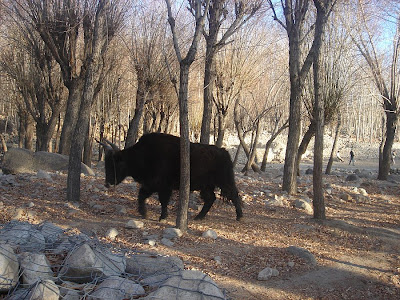Kaspang, Ladakh
For today's entry I am nicking the title of a pre-existing book about the
Green, gold, grey, white. I have seen the Ladakhi landscape completely change colours four times. When I arrived in August the valleys were lush and green. The green turned to amber gold. There are a few weeks before the serious snow when everything just appears grey. Now from Hemis onward the valleys are blinding white, and the Indus, still running turquoise, is edged in ice.
The picture above was taken from the rooftop of Chemdey Gompa near Serthi ("Sakti") village.
Changes in latitude, changes in attitude
I had such a perfect "last day in Ladakh" on Dec. 19th, with trips to Chemdey and TakTok gompas and cozy, glowing village homes, that I decided to extend my stay another 2 days, into the Winter Solstice. There was a special chaam (ritual masked dance) at Chemdey monastery, and I was invited. A special chaam dance at a monastery on the Solstice - I couldn't resist.
As luck would have it, yesterday I ended up with altitude sickness, which ruined the next 18 hours. How, after 4 months at 13,500 feet, did I end up with altitude sickness, you ask?
I was invited to visit a remote (really remote) mountain monastery called Kaspang, past a valley called Igu, way out past Karu village. "It is so beautiful!" enthused my friends. "You won't believe it."
When we arrived at Igu Village, the entire local populace appeared to be
 out in the winding street, except for a few kids with makeshift snowboards who were skating on the frozen river. It turned out to be a cremation and funeral. A young woman of the village had died - no more than 25 years old or so.
out in the winding street, except for a few kids with makeshift snowboards who were skating on the frozen river. It turned out to be a cremation and funeral. A young woman of the village had died - no more than 25 years old or so.My friends and the driver could not be deterred from their mission to the monastery. So we drove through lanes that became increasingly less dirt and more snow. About 2 kms from the monastery, the road was just covered in snow - about 4 inches. Not bad to walk in, but too much for the car (not a jeep) to make it uphill.
My Ladakhi friends insisted we abandon the car and walk, uphill, for the next 2kms. After about 1000 feet it became painfully- literally painfully - obvious that we were up too high for me to go hiking.
"How high are we anyway?" I puffed, seeing sparkles like confetti before my eyes.
"Oh, about 15,000 feet" Dorje answered.
For a Ladakhi, that is no problem. For ordinary lowlanders, once you get
 about 10,000 feet, every 1000 feet or so requires a new adjustment period. If you don't believe me, just try it.
about 10,000 feet, every 1000 feet or so requires a new adjustment period. If you don't believe me, just try it.At this point we had been at 15,000 feet about 2 hours. We had gained about 1,500 feet from our starting point in Leh valley. I was suffering in a very real way from altitude. My Ladakhi friends, never having been in this situation themselves, refused to recognize it.
"Come on! It will take only half an hour!" I looked up at the gompa in the distance, which with its white walls against the white mountains, felt like a mirage. It was at least one and a half hour's walk by my speed - including breath-catching stops. My friends could have walked the whole thing in half an hour.
Blood singing in my ears, I turned and looked back where we had walked. The entire panorama was just like Seven Years in Tibet or the Shangri-la movie of your choice - unbelievably austere, lonely, purified by aeons of snow which managed to be crunchy and soft at the same time. Amazingly, not so cold, especially when you are hiking. And no wind.
In the distance a lone man in a black
I looked down. Tracks of mysterious animals made pie-crust patterns across the powder. Sometimes the tracks criss-crossed one another. The trident shape of a partridge or magpie's feet, what looked like the petite hopping of a snow rabbit, and one kind of track that appeared in sets of three. Must have been a galloping wolf.
Back to reality. "There's no way," I said. "I can't make it. Sorry to ruin all your fun." From the comments, it was obvious my companions just thought I was being a wimp. Literally, I would walk fifty feet and have to collapse onto a rock. Still, they thought I was malingering.
My head was spinning. I heard one of them say, "Come on, take a picture of me with the gompa behind!" (I was the only one with a camera (quite possibly the reason I was invited.)
Finally I got angry. This s*** is dangerous, and here they were joking around about it. "Can you not see," I hissed, "that I am SICK, and ready to collapse? I am NOT laughing. This is NOT a joke. I have every single symptom of altitude, and still you won't listen to me!!! We have to go down." As soon as I was able, I wheeled around and began backtracking firmly toward the car.
By the time we got back to Igu, we had been at 15,000 feet nearly 3 hours. It took nearly the next 24 hours to recover. Moral of the story if you are not Ladakhi: Don't go trekking with Ladakhis (or Tibetans) who are not professional guides. They think you are faking altitude sickness. In a way, it makes sense. They have never and probably will never experience it themselves, unless they climb Everest. Moral of the story if you are Ladakhi: don't take foreigners up to 15,000 feet and then expect them to hike up a hill, unless you want to carry them back down.
Down to earth
When we finally got to Igu, we stopped at the house of a distant relative (all Ladakhis appear to be cousins of cousins of second cousins from their father's village). As if to prove my symptoms were real, I dropped my glass of butter tea on the floor. "I don't have coordination yet." Then I dropped a biscuit someone handed me. And I couldn't really hear anything anyone was saying - like being underwater. It's like being drunk without any of the fun.
Eventually, after seeing me move like a drunkard, my friends started to take the condition seriously. I am still pissed off that it ruined the last day and half in Ladakh. I did get to take a fun sleeping pill at home to help me sleep it off and recover, though.
Strike!
The very last day (today) was additionally ruined by the LUTF strike. All shops were closed till about 3pm. Altitude sickness, beautiful scenery, spilt butter tea and political strikes - all in all a very Ladakhi day or 2.
Lamawatch
After the teachings at Mundgod, Karnataka, HH Dalai Lama will hoof it to Ahmedabad, the capital of Gujarat, to open a Tibet festival, make a bunch
 of speeches and inaugurate a bunch of stuff. Here's the news item.
of speeches and inaugurate a bunch of stuff. Here's the news item. I am interested to see HH on Gandhi's home turf, which has been so wracked by communal violence. I wonder if any local groups will invite him to address the subject.
Here is a photo I took of HH at the Hindu Long-Life puja in Dharamsala, back in April. I wonder whether he is looking at me saying, "So good to see you!" or, "You again!!!" Or maybe, "Get outta my way already...."














1 comment:
I love that photo of the Dalai Lama. I'm sure he was happy to see you - come on!
You're so right about the altitude - I totally understand. When I did the kora around Mt. Kailash a few years ago, I had to sit down and rest every 50 feet or so ... I would look at my watch and think I had been walking half an hour - and it had only been 5 minutes! And I had been in Tibet for 3 weeks at that point, but Kailash is 17,000 ft. Even base camp at Darchen is 13,400. Very, very tough. Glad you got back safely.
Post a Comment